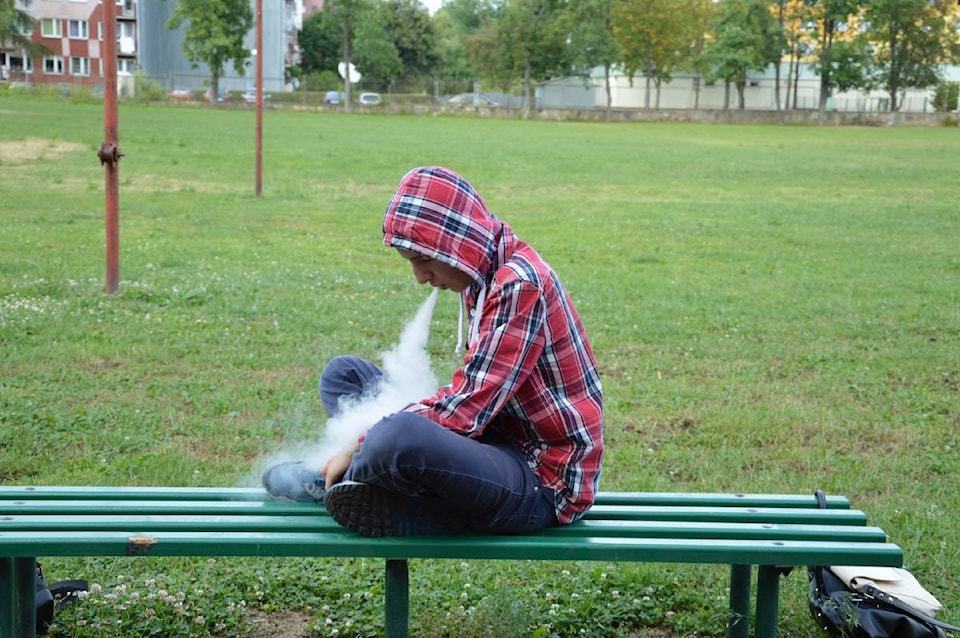Students in the Fraser Cascades area are more likely to vape than the average youth in B.C.
That was one of the statistics that came out of Dr. Alexandra Choi’s presentation to Kent council Wednesday (Nov. 13) on the potential dangers of vaping.
“It’s concerning to us that we’re seeing the first increases in nicotine use in probably 20 or 30 years with the introduction of vaping products,” Choi, the medical health officer for the eastern Fraser Valley, said.
According to a 2018 study from the McCreary Centre Society, 21 per cent of B.C. youth in grades seven to 12 vaped with nicotine, while 19 per cent vaped without nicotine and only 7 per cent used cigarettes in the last month.
As survey participants could choose more than one answer (they could say they vaped with nicotine and also without nicotine in the last month), Choi estimated about 20 per cent of youth in B.C. had used vape products. In the Fraser Cascades, that number was higher: around 28 per cent.
RELATED: SD78 asks for vaping controls, education
“This is a group that we’re particularly concerned about, because many of these youth have never smoked before,” Choi said.
Choi’s presentation went over the basics of what vaping was, outlining how vape pens and e-cigarettes work, and what harms could be in the vapour products themselves.
“A lot of teenagers these days have heard of things like popcorn lung, which is caused by diacetyl, which found in popcorn flavour e-cigarettes,” she explained. (The term “popcorn lung” was coined nearly two decades ago, when eight workers in a microwave popcorn factory developed lung scarring after breathing in vapour from the butter-flavour additive.)
“That is still in there, that is not limited by Health Canada.”
Choi also commented on other problematic flavours, such as cinnamon, which could be irritating to the lungs, as well as the potential of vape pens releasing heavy metals when the liquids are heated.
There are also concerns around high concentrations of nicotine in vape products. Choi said during her presentation that there have been significant overdoses related to nicotine, particularly in toddlers and other young kids who accidentally ingest vape juices.
The day after her presentation to council, the province unveiled new regulations around vaping products that will restrict the levels of nicotine in vape juices, as well as bring in a 20 per cent tax around them.
RELATED: B.C. to restrict nicotine content, bring in 20% tax on vaping products
The new rules, although in line with some of what Choi was asking for from governments around stronger regulations, doesn’t affect what she saw as the biggest worry around vaping: a lack of research.
“There is a lot more research needed,” she said. “These things have not been around for very long … we’ve really only seen the increase since 2015 in terms of use, and use in teens have rapidly spiked in the last couple years.”
“There’s also this issue with vaping injuries,” she continued, referencing the handful of vaping injuries in Canada and the thousands in the United States. “It’s quite concerning. It’s unclear what this is linked to yet, so right now our advice is to not use any e-cigarettes if that’s possible.”
The main goal of Choi’s presentation was to bring some of the current information about vaping to council, in hopes that they could enact stronger bylaws around where people can vape.
In April of this year, Kent strengthened some of their smoking bylaws to prohibit cannabis and vape products in the same places where tobacco is also banned, such as on school property and in transit shelters. (Cannabis is also prohibited in a number of other areas, including on sports fields and in parks.)
RELATED: Kent approves new rules for pot, tobacco smoking in the district
These rules closely follow provincial legislation around where people can smoke. Although Choi didn’t provide any direct comment on Kent’s bylaw, it seemed as though she was asking for more.
“This is definitely not comprehensive in terms of the areas people can access these things,” she said about the provincial legislation around where people can smoke. Restricting where vaping products can be used “is probably the easiest way to do it … tie it in to tobacco and make it all one in the same.”
She added that other options included prohibiting vape products on all patios, outdoor parks and recreation areas, hotels and motel rooms, sidewalks and boulevards, as well as new multi-unit properties. (These are many of the same areas where cannabis has been prohibited in the District of Kent.)
In addition to her presentation to Kent council, Choi will also be speaking at a vaping panel at AESS on Thursday, Nov. 28.
Jointly hosted by the school and Fraser Health, the panel is aimed at helping parents better understand the challenges and research around vaping. Choi will be joined by Ben Canfield, a respiratory therapist with Fraser Health, and Tracey Jirak, coordinator for the tobacco cessation and reduction program with the First Nations Health Authority.
The community information meeting will begin at 7 p.m. in the AESS library, and is free to attend.
grace.kennedy@ahobserver.com
Like us on Facebook and follow us on Twitter
